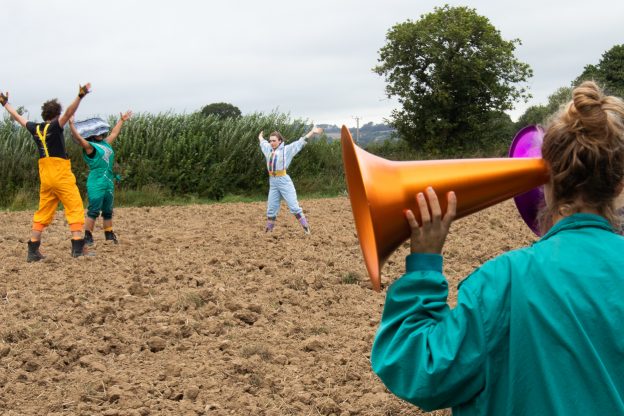Just what do we mean by environmental art? Dorothy Max Prior reflects on work seen at Symondsbury Estate on the second weekend of Inside Out Dorset, a biennial outdoor arts festival commissioning and presenting performance and installation work that engages meaningfully with the landscape in which it is sited
Environmental art-making is on the up. In the light of the deepening climate crisis, and other looming ecological concerns, more and more artists and theatre-makers have taken to the stage or gallery to express their concerns in plays or performance pieces or installations – and, we presume, to attempt to change the way people live.
But for some of us, the fact that these shows take place within a theatre/performance culture that encourages the constant carting of large amounts of kit across the country in trucks, then using ecologically unsound buildings to show the work for very short runs before heading off to the next town, rather defeats the message. Especially as so often costumes and set are made from scratch and ditched at the end of the show’s run.
For many artists with an interest in true environmentalism, decisions were made (even before Covid forced their hand) to step off of that treadmill, and instead make work that was not ‘about’ environmentalism, but was truly environmentally conscious in its approach: sited outdoors in the landscape or a found site, responding to that site in the devising process and using very little in the way of ‘set’, instead making use of the natural environment as the staging.
Inside Out, presented in Dorset biennially by Activate Performing Arts, has been promoting such an approach for many years. In this edition, there was a particular emphasis on work that engages with the land, and support for artists working in environmentally sound ways, with three special commissions from Red Herring Productions, Lorna Rees, and Dave, The Shouting Mute.
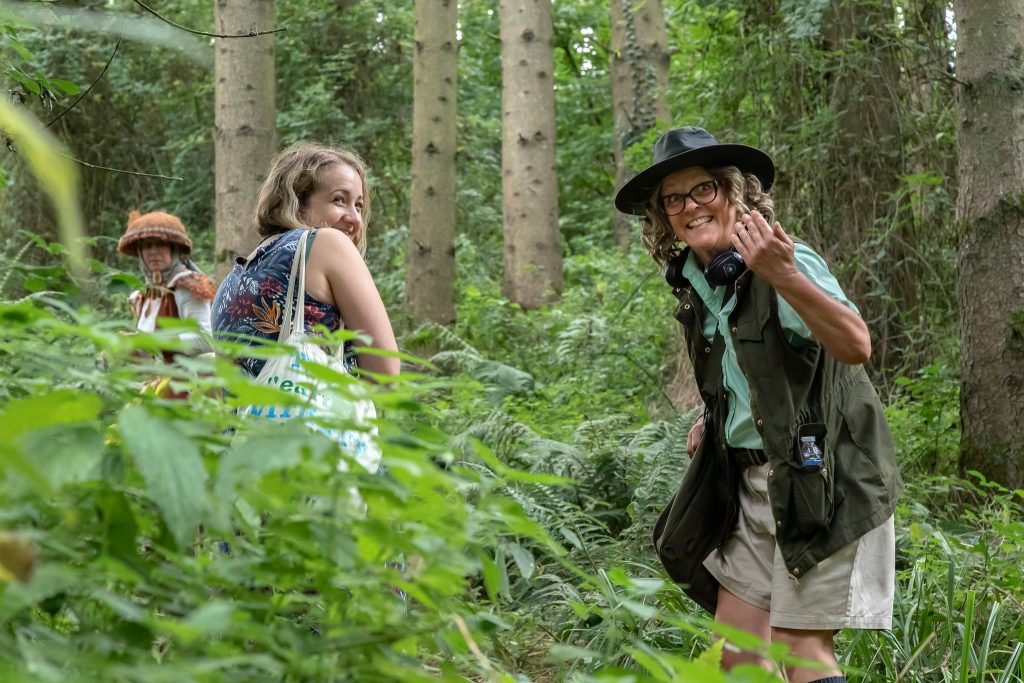
Red Herring are led by Paschale Straiton – who reflected most eloquently in an article here on Total Theatre Magazine on the notion of hyperlocality, a recent buzzword that can mean many things, but surely one of them is a focus on working close to home, exploring and making artistic use of the local environment.
Their latest work, Whistlers, is an absolute delight. A clever theatrical wheeze is set up at the start. We meet at an information tent on the edge of the woods, and learn all about The Whistler Conservation Society, who are apparently here in Symondsbury following the sighting of a couple of ‘Whistlers’ – a little-known human tribe who live in close, symbiotic relationship with songbirds and communicate by whistling. We are then joined by a khaki-clad jolly-hockey-sticks anthropologist called Lynne Passerine, who tells us that she is director of the Whistler Conservation Society. She issues us with headsets and marches us off to a campfire in the woods, where we hear her enthusiastic stories of trips to the Georgian Caucasus and other far-flung places in a quest to find Whistlers. Imagine, then, her joy at spotting a female Whistler in these very woods! We are invited to follow her deeper into the woods, on an expedition to hear, and perhaps if we are very lucky, see a real live Whistler. And so off we trek…
We stumble up and down steep red-earth paths, trip over roots, and crouch Ninja-style when a distinct and unusual bird whistle is heard. We pass trees decorated with interesting symbols and markings – some look South American, others reference European folk art. I don’t think I’m giving too much away if I tell you that we do, eventually, make Whistler contact – and are subsequently brought into a number of lovely, and often very funny, Whistler rituals. Water and twigs, wooden bowls filled with feathers, and a delightful pair of leafy wings are all employed. I particularly enjoy the small child next to me resolutely chewing on a twig-worm a Whistler has given him, despite his mother’s concerns about him eating dirt and twigs…. All three (female) performers are excellent, the folkloric costumes lovely, and the use of the natural environment for props, with the landscape and the lovely tree installations as the ‘set’, is perfect. The soundtrack of bird and human whistles is great – the aural build as we come closer to the Whistlers’ hang-out works particularly well. I do wonder about the use of the headsets, which give a disconnect with the environment – but end up realising that this is probably so that the real birds aren’t overly disturbed by bird recordings and human whistlings!
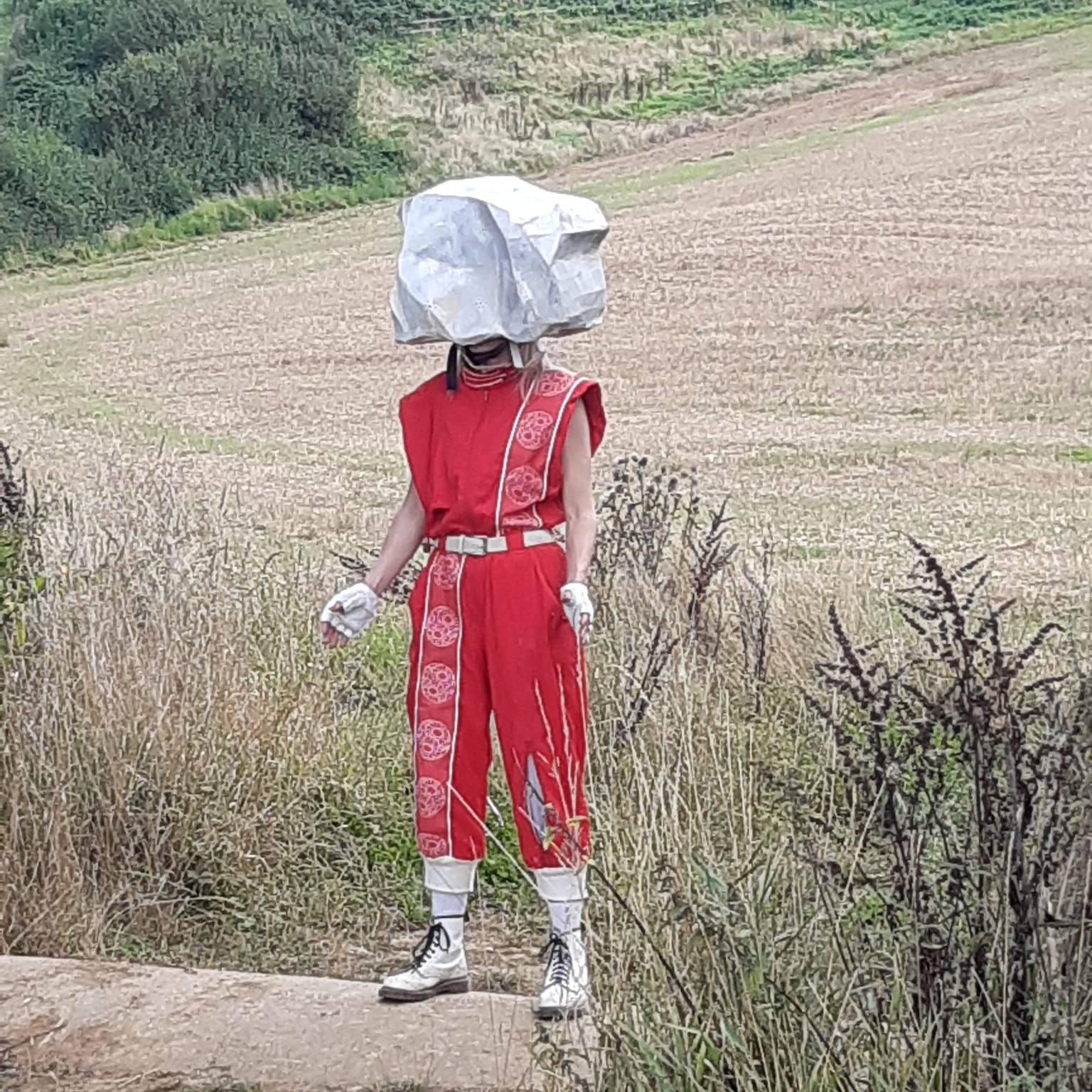
Animal, vegetable, mineral? When we think of our relationship with the ‘natural world’ often it is animal or plant life that comes first to mind. But for performer, musician and sound artist Lorna Rees, creator of Geophonic, it’s the mineral world that has caught her attention…
Geophonic is a site-responsive performance piece and sound walk, encouraging audiences to listen to the geological processes of the Earth. ‘We’re interested in the physical narratives of rock, sci-fi and geology on a human scale. It is a work hugely bound up in notions of custodianship of the natural world’ says the artist on her website.
At the start of what turns out to be a pretty long walk along country lanes, we are issued with lovely hand-spun aluminium ‘geophones’ (available in purple, copper or blue) that are rather like a child’s take on a traffic cone, and encouraged to listen to sounds natural or human-made at different points on the journey, these moments indicated wordlessly by our guide, Adam Coshan. He introduces the walk with a note on the three types of rock: igneous, metamorphic and sedimentary. That didn’t really sink in at the time, so for your elucidation (and mine), here’s Wiki: ‘Igneous rocks are formed from melted rock deep inside the Earth; sedimentary rocks are formed from layers of sand, silt, dead plants, and animal skeletons; metamorphic rocks formed from other rocks that are changed by heat and pressure underground.’
So, off we march, encountering tableaux and performance vignettes along the way, these enacted by a ‘rock group’ (ha!) – a troupe of five performers (including Lorna herself) who don magnificent whole-head masks to become, say, ‘Coal’ or ‘Quartz’ or ‘Chalk’. Some of the pieces are silent ensemble movement pieces, some are solo acapella (‘Chalk’s lament for a billion micro-organisms’), some are whole-group music songs (one a fabulous local folk tune augmented by field recordings). In one of my favourite moments, Lorna/Coal stands still, silent and alone in the centre of a a field as we walk by. The five performers use bicycles to get from one location to another. I enjoy the performers’ ritual removing of rock masks and donning of bike helmets – and there are also some lovely moments en route as we and the cyclists are passed by other road users: at one point a horse-riding lesson goes by, and at another a blushing farmer drives a tractor through a guard-of-honour of audience members lining the track.
A small quibble: our guide had asked us at the beginning to stay together in one group, but he walks rather too quickly – so the eldest and youngest in the group (including me!) end up straggling behind, meaning we often experience the tail end of the tableaux or performance pieces sited in the fields to the side of the paths. I suspect because it’s such a long route, and there’s a constant need to get to the next location.
Another vital element – working alongside the visual pictures, live music and physical actions – are pre-recorded soundscapes incorporating, literally, the sounds of the earth: Icelandic volcano eruptions, lava flow in Hawaii, sounds from local coves and rivers in Dorset, sounds from coal faces in Wales and Kent. These are sometimes in a pure state, sometimes worked into a sound art piece (by Laura Reid and/or other contributors). The sound recordings are presented nicely, emanating from coloured metal boxes containing Minirig speakers which are sat in fields or by the roadside – but again, I feel hurried, and don’t get enough time to take in the sound art work.
Another favourite moment is the fabulous ‘Hutton’s Unconformity Scottish Reel with Intruding Quartz’ which sees four of our fab five jigging around in folksy set-dance harmony whilst Quartz (played by China Blue Fish) vogues, catwalks and poses like crazy. So along the way, we’ve morphed rather marvellously from slightly po-faced ‘art’ (tongue-in-cheek, I do believe) to full-on silliness. There is a joyous ending as we are all brought into the dance with The Temptations’ ‘Standing on Shakey Ground’ – a reminder that ‘even rocks don’t last forever’.
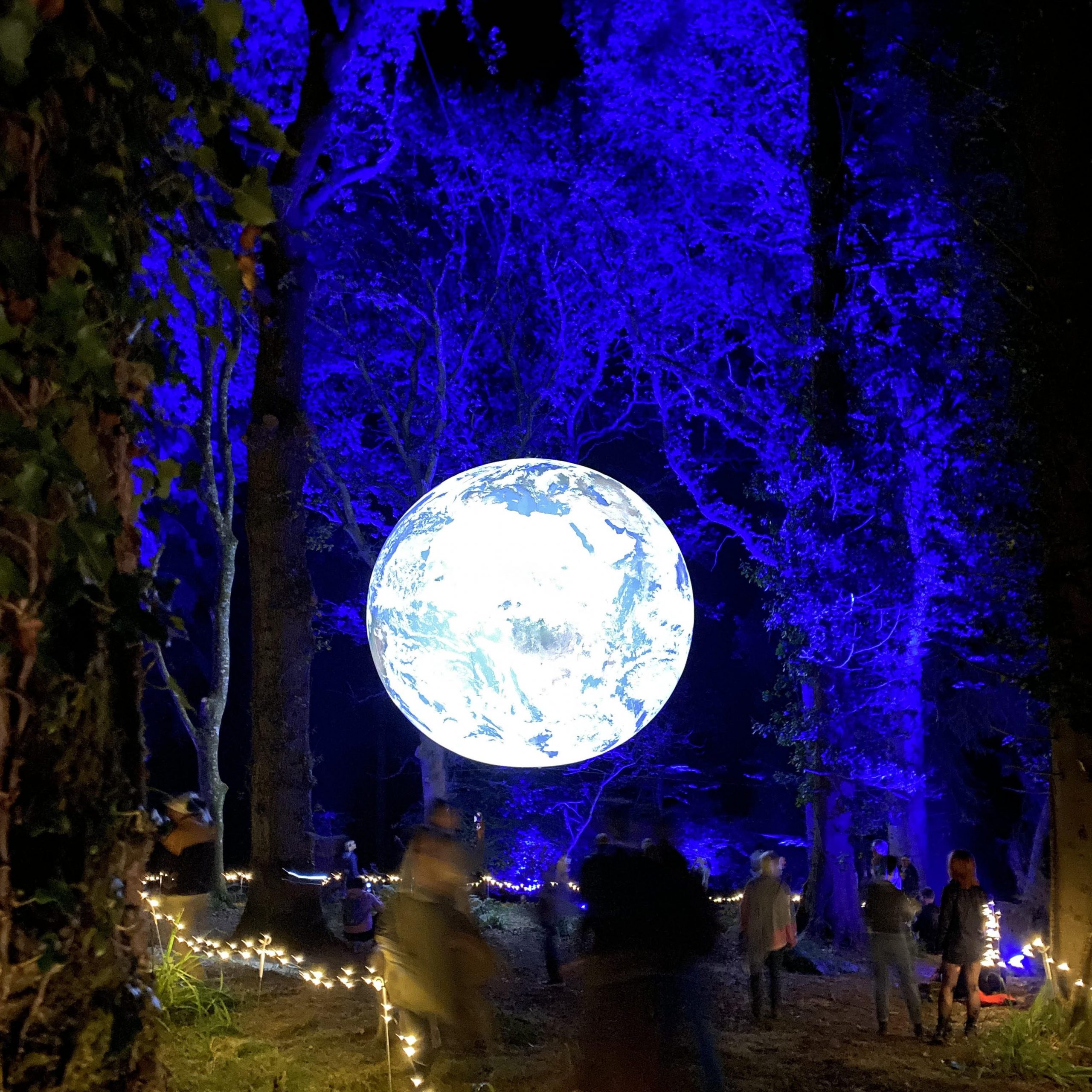
From humans and birds to rocks to – the whole world! Gaia in her entirety! Having previously brought us The Museum of the Moon, artist Luke Jerram has subsequently turned his attention to the earth. Measuring seven metres in diameter, and featuring 120dpi detailed NASA imagery of the earth’s surface, Gaia is indeed an awesome piece of work – particularly as seen in the extraordinary setting of Park Copse, part of the Symondsbury Estate. It can be experienced daytime or evening. I opt for evening, and join a group that goes on an adventurous post-supper trek by torchlight past farmland and into the wilds of the woods, rough and steep tracks winding up to the top of a hill, then curving down into the secret location. There is a gasp-worthy moment as we see the sculpture gradually emerge from behind the dense forestation, finally finding ourselves in a circular glade surrounded by enormous trees, Gaia suspended in the middle of it all, inviting us to view our world from a different perspective. I can see that everyone around me is similarly in a daze as we look and listen. The soundscape, by composer Dan Jones (founding member of Sound and Fury Theatre Company) weaves together words from astronauts viewing the earth from space, with other found sounds and composed ambient music – the soundscape and sculpture together exploring what has been called ‘The Overview Effect’ which highlights ‘a feeling of awe for the planet, a profound understanding of the interconnection of all life, and a renewed sense of responsibility for taking care of the environment’. We could say that in this case it is more of an ‘underview’ rather than ‘overview’ effect, as we walk below the sculpture then all around it, but viewing Gaia in such a stunning location is indeed an awe and wonder moment – a perfect match of artistic concept and location.
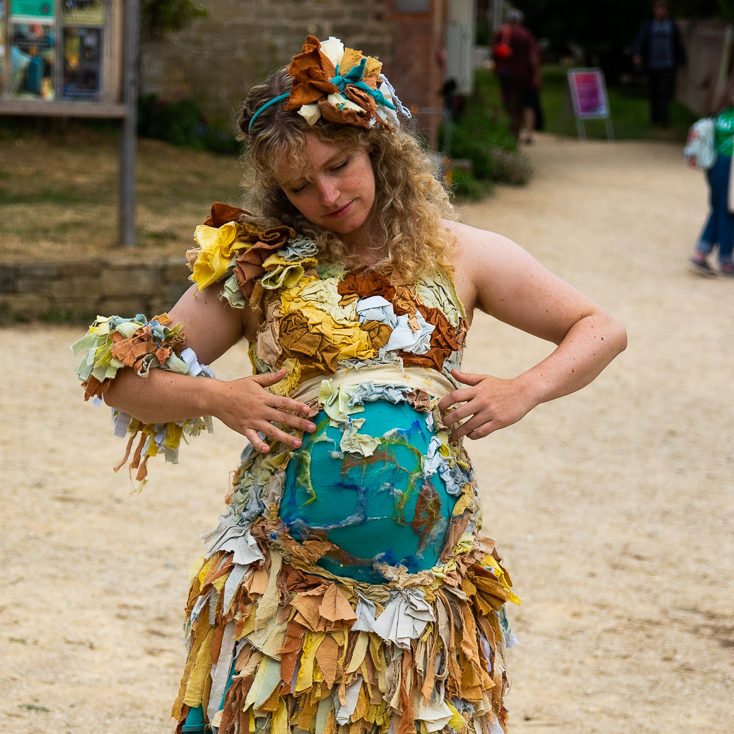
Meanwhile, back at base camp – the gardens just outside Symondsbury Estate’s lovely cafe and shop – Partnering with Earth, by Dave Young (aka Dave, The Shouting Mute), asks: ‘If the earth could speak, what would it say?’. Gaia is now personified as a pregnant woman, an Alice wandering through an upcycled Wonderland accompanied by a quizzical Queen of Hearts and a Mad Hatter cum bumbling Prime Minister. Two sets of dining tables and chairs, beautifully reworked by designer Sophie Fretwell, offer us a place to listen or join in on the reflections on politics and the ecology. One table, focusing more on the problems, is painted black and features bin-bag upholstery and a heap of toy cars. The other table, focusing on solutions, is painted green and decorated with flowers. Here, we are invited to take up chalk and contribute our thoughts on what we are going to do for the world. There is live dialogue, but also a pre-recorded soundscape (by Jonathan Leitch) which incorporates Dave’s interviews with local farmers, scientists and activists about their relationship with the landscape in Dorset, and their views on climate change. This merged with poetic text written by Dave. Costume designs – like the set/installation, all made from recycled materials – were created by the Arts University Bournemouth’s project Costumes for Change.
I enjoy the piece, with some reservations. I love the visual elements – costumes and installations – and the sound work, but balk a little at the rather polemical nature of the piece – the exhortations to recycle and use cars less feels a little like preaching to the converted (although, naturally for an event in a countryside setting, the car park is full – so perhaps not? It’s going to take a lot to get this audience to abandon their cars, I fear!) I also find myself musing as I watch and listen that there are some – including the more hardcore elements of the Extinction Rebellion cohort, now working under the Beyond Politics or Burning Pink banners – who feel that putting the emphasis on individual responsibility is pointless when actually it is a handful of companies worldwide who are causing most of the polluting…. But I park that thought for another day!
Across the way, in a grass bowl to the front of the house, another piece takes an ecological stance – this time, it’s a word-free dance work, Rodadoras, by Becky Namgauds. Set to a score of Neapolitan folk music, and performed on a bed of soil by three women dancers, Rodadoras explores ecofeminism. I miss the first half of this 24-minute piece, so I don’t know how it starts, but at the point at which I come in, I witness an intense choreography in the José Limón /Doris Humphreys style: lots of reaching, bending, slamming into the ground; playing with weight, and exploring the rhythms of falling and recovering balance. The three women toss back long manes of hair, and roll ecstatically in the earth. The message here is a purely physical and visceral one: the female body free from the restrictions of the male gaze, and the constraints of polite society, just being herself – wild and free. Another view of Gaia, perhaps?
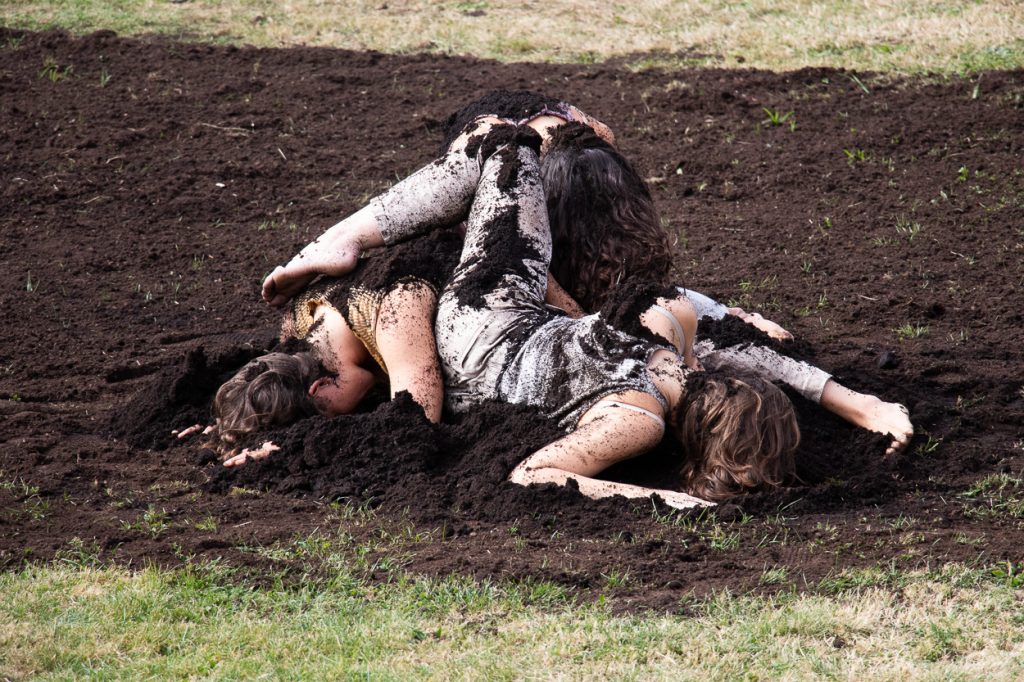
Featured image (top): Lorna Rees: Geophonic. Photo Mike Petitdemange.
Dorothy Max Prior attended the Inside Out Festival Symondsbury Estate programme on Friday 24th and Saturday 25th September 2021.
Biennial outdoor arts festival Inside Out Dorset, postponed from 2020, ran 17–26 September 2021, celebrating the county’s natural landscape and sense of place, transforming it with art and performance in both rural and coastal locations, including: Poole, Christchurch, Weymouth, the Moors Valley Country Park and Forest, and the Symondsbury Estate. All events were free to attend. insideoutdorset.co.uk
Inside Out Dorset is funded by Arts Council England and presented by Activate Performing Arts. Activate exists to promote, support and produce performing arts projects in its communities. For over 30 years it has brought world-class events to unexpected places, such as town centres, village squares, beaches and hilltops. activateperformingarts.org.uk

